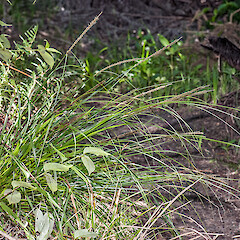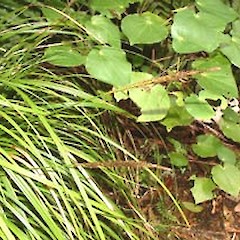Carex uncinata
Common name
bastard grass, hook sedge, kamu, matau-a-maui
Synonyms
Uncinia uncinata (L.f.) Kük.; Uncinia australis Pers.; Uncinia alopecuroides Colenso; Uncinia bractata Colenso; Uncinia pedicellata Kük.; Uncinia uncinata var. pedicellata (Kük.) Petrie; Uncinia australis var pedicellata (Kük.) Petrie; Uncinia uncinata var. laxior Carse;
Family
Cyperaceae
Flora category
Vascular – Native
Endemic taxon
No
Endemic genus
No
Endemic family
No
Structural class
Sedges
NVS code
The National Vegetation Survey (NVS) Databank is a physical archive and electronic databank containing records of over 94,000 vegetation survey plots - including data from over 19,000 permanent plots. NVS maintains a standard set of species code abbreviations that correspond to standard scientific plant names from the Ngä Tipu o Aotearoa - New Zealand Plants database.
UNCUNC
Chromosome number
2n = 88
Current conservation status
The conservation status of all known New Zealand vascular plant taxa at the rank of species and below were reassessed in 2017 using the New Zealand Threat Classification System (NZTCS) – more information about this can be found on the NZTCS website. This report includes a statistical summary and brief notes on changes since 2012 and replaces all previous NZTCS lists for vascular plants.
Please note, threat classifications are often suggested by authors when publications fall between NZTCS assessment periods – an interim threat classification status has not been assessed by the NZTCS panel.
- Conservation status of New Zealand indigenous vascular plants, 2017 . 2018. Peter J. de Lange, Jeremy R. Rolfe, John W. Barkla, Shannel P. Courtney, Paul D. Champion, Leon R. Perrie, Sarah M. Beadel, Kerry A. Ford, Ilse Breitwieser, Ines Schönberger, Rowan Hindmarsh-Walls, Peter B. Heenan and Kate Ladley. Department of Conservation. Source: NZTCS and licensed by DOC for reuse under the Creative Commons Attribution 4.0 International licence.
2017 | Not Threatened | Qualifiers: SO
Previous conservation statuses
2012 | Not Threatened
2009 | Not Threatened
2004 | Not Threatened
Distribution
Indigenous: New Zealand. North, South, Stewart, Chatham and Auckland Islands. Also in the Hawaiian Islands.
Habitat
Coastal to montane (up to 1000 m a.s.l.). Widespread and common in most indigenous habitats from dense forest to open shrubland. Rarely colonising the margins of wetlands. Sometimes found as an urban weed in hedgerows, along river banks or in parks.
Wetland plant indicator status rating
Information derived from the revised national wetland plant list prepared to assist councils in delineating and monitoring wetlands (Clarkson et al., 2021 Manaaki Whenua – Landcare Research Contract Report LC3975 for Hawke’s Bay Regional Council). The national plant list categorises plants by the extent to which they are found in wetlands and not ‘drylands’. The indicator status ratings are OBL (obligate wetland), FACW (facultative wetland), FAC (facultative), FACU (facultative upland), and UPL (obligate upland). If you have suggestions for the Wetland Indicator Status Rating, please contact: [Enable JavaScript to view protected content]
FACU: Facultative Upland
Occasionally is a hydrophyte but usually occurs in uplands (non-wetlands).
Detailed description
Caespitose, yellow-green to dark green sedge. Culms 100–900 × 1.0–1.5 mm, glabrous, or occasionally scabrid just below inflorescence; basal sheaths dull brown. Leaves 5–10 per culm, ± = culms, or > flowering culms, 2–5 mm wide, dark green or occasionally reddish green, strongly scabrid on the margins and on the adaxial surface towards the tip. Spikes 55–200 × 2.0–3.5 mm, usually bracteate, female flowers numerous, usually c. 60–120, very closely crowded throughout almost the whole spike, internodes 0.5–1.5 mm long. Glumes usually < but occasionally slightly > utricles, deciduous, ovate, obtuse or subacute, coriaceous, yellowish with a green midrib or often entirely dark brown, occasionally greenish pink. Utricles 4–5 mm long, slightly > 1 mm. diameter, plano-convex or concavo-convex, lustrous, with usually one prominent lateral nerve on the abaxial face and 3–4 faint nerves on the adaxial face, yellowish to dull brown, stipe 1.0–1.5 mm. long, beak slightly > 1 mm. long; scarcely spreading when ripe.
Similar taxa
Carex uncinata is the most variable of the New Zealand species. It is chiefly distinguished by the number of female flowers which range from 35–180, and by the length of spikes (55–200 mm long). The glumes of this species are also characteristically deciduous. However, some forms are known where the glumes are persistent. The leaves of C. uncinata are usually dark green to yellow-green but in the southern part of its range dark red colour forms are known.
Flowering
August–December
Fruiting
Throughout the year
Propagation technique
Easily grown from fresh seed and by the division of established plants (though these may then take a while to settle). In the southern part of its range C. uncinata plants are often dark wine-red, it is this form which is erroneosuly sold as Uncinia rubra in the horticultural trade.
Etymology
carex: Latin name for a species of sedge, now applied to the whole group.
uncinata: Hooked
Attribution
Fact Sheet prepared for NZPCN by P.J. de Lange (18 August 2006). Description adapted from Moore and Edgar (1970) - see also de Lange et al. (2013).
References and further reading
de Lange PJ, Heenan PB, Rolfe JR. 2013. Uncinia auceps (Cyperaceae): a new endemic hooked sedge for the Chatham Islands. Phytotaxa 104(1): 12–20. https://doi.org/10.11646/phytotaxa.104.1.2
Moore LB, Edgar E. 1970. Flora of New Zealand, Volume II. Indigenous Tracheophyta: Monocotyledones except Gramineae. Government Printer, Wellington, NZ. 354 p.
NZPCN Fact Sheet citation
Please cite as: de Lange, P.J. (Year at time of access): Carex uncinata Fact Sheet (content continuously updated). New Zealand Plant Conservation Network. https://www.nzpcn.org.nz/flora/species/carex-uncinata/ (Date website was queried)















